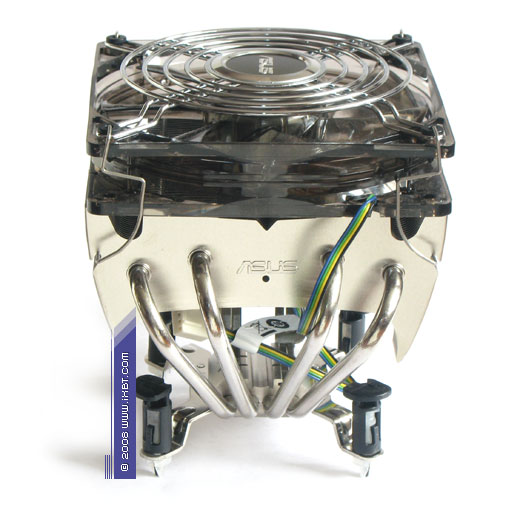Triton 85
The other cooler to be examined today is Triton 85. It looks less ambitious, no apparent signs of hightech elements and eastern myths in its technical image. Nevertheless, this one is also designed well -- we should note an imposing combination of a copper heat sink (50x30x6 mm, 30x30 mm at the base), 4 copper heat pipes (6 mm in diameter), and a large aluminum fin stack (120x110x55 mm), spiced up with a 120x120x25-mm fan (1300 rpm, PWM control).

Triton 85 also has a good thermal design -- horizontally oriented fin-stack (55 fins, 0.2-mm thick, placed at 2-mm steps) plus developed heat exchange surface area (about 3500 cm2). Note that working zones of heat pipes are moved to periphery of the heat sink -- that is to the zone of pronounced air flows. This is done to intensify heat release along the pipes-fins line and thus optimize full thermal resistance of the cooler. Another interesting improvement in the body of this cooler is an additional stop (or a slingshot), which blocks pipe curves and protects the heat sink from accidental mechanical damage.

However, there is one negative nuance in Triton 85, when we speak of the contact between heat pipes and fins: fins are just pressed on the pipes instead of soldering (the most productive method to provide thermal contact between pipes and fins). This is not very good, as far as technical etiquette is concerned. But the joints are very tight, and the critical contact between the heat pipes and the base is soldered. So in the grand scheme of things, this sin is not very important. Besides, judging by results of this cooler, it does not have a serious effect on its thermal resistance.

We should scold ASUS engineers for careless selection of the on-board fan -- Power Logic PLA12025S12L-4. In fact, we don't have any serious gripes with this fan -- it demonstrates good technical design, but its purely budget setup (plain bearing, simplified electrics, non-advanced aerodynamics of the impeller) looks poor in High-End terms of Triton 85. It's quite clear that this feature does not contribute to the functional image of this premium-class cooler -- ASUS has some job to do here to improve the product.

What concerns usability, all catch questions are discarded automatically -- ideology of the retention module used in Triton 85 is similar to Lion Square in many respects, ergonomic design of the latter is preserved and even improved. For example, on the AMD Socket AM2 platform the cooler is also installed with the familiar mounting bracket -- fast and easy, no more difficult than with typical boxed coolers. We had no problems with the Intel LGA775 platform either, where Triton 85 is installed with two brackets and reference latches. There is no need to remove a motherboard from an enclosure in this case. The cooler itself sits tight in a socket and its pressure on the processor is within specs, partly owing to its balanced weight (about 530 g).

We should also mention the bundled thermal grease -- we already mentioned its High-End thermophysical properties in our review of Silent Knight II. It's no less effective with Triton 85. Success of this thermal grease is based on the proven composition of thermally conductive fill and saturated consistency adapted for complex rough surfaces. Besides, just as in case of Lion Square, we shouldn't forget about such a useful feature as PWM control (600-1300 rpm). Triton 85 is not truly ergonomic in nominal noise characteristics even taking into account its low fan speed. In order to obtain optimal noise characteristics, this cooler requires adequate fan speed control. And PWM control copes well with this task, as it's widely used in PCs.
Well, we've cleared up questions of technical design and usability issues, there is no need to elaborate. It's time to address the main aspect of our article -- test results of our coolers under review, Lion Square and Triton 85.
Write a comment below. No registration needed!






